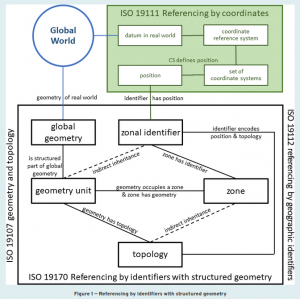DGGS/Terms
- Português em DGGS/Terms/pt
"DGGS Terminology", from the open and most recent version of the (ISO) DGGS standard,
https://docs.ogc.org/as/20-040r3/20-040r3.html#toc11
Primitive terms:
A estrutura para a geometria DGGS é fornecida por um processo estritamente controlado de tesselação recursiva da geometria-mãe que cria as unidades de geometria do DGGS RS. A região ocupada por cada unidade de geometria é chamada de zona. Cada zona recebe um nome exclusivo, chamado identificador de zona. Cada identificador zonal está associado a uma posição espaço-temporal representativa em um CRS base (sistema de referência de coordenadas) definido por um datum para o mundo global do DGGS. A melhor prática é que um identificador de zona seja uma codificação de sua posição e de sua topologia. A referência por identificadores com geometria estruturada dá origem a RSs que usam identificadores zonais com geometria estruturada.
A informação geográfica é inerentemente quadridimensional e inclui o tempo. Portanto, um modelo de dados espaço-temporais unificado para sistemas de coordenadas, geometria, topologia, identificadores e RSs usando identificadores é um pré-requisito para DGGSs espaço-temporais
Contorno
conjunto que representa os limites de uma entidade. Delimitação, contorno.
Cell
DGGS spatial, spatio-temporal or temporal unit of geometry with dimension greater than 0, associated with a #zone.
- Note 1 to entry: All cells within a DGGS (Clause 4.13) share the dimensionality of the DGGS’s parent global (Clause 4.24) geometry. DGGS with dimensionality of 0, are not supported.
- Note 2 to entry: Cells are the unit of geometry in a DGGS, and the geometry of the region of space-time occupied by a zone is a cell.
- Note 3 to entry: While the terms cell and zone are often used interchangeably, strictly zone is the preferred term. Cell is entirely appropriate when specifically discussing a zone’s geometry or topology.
cell refinement
DGGS process of subdividing #parent cells into descendant #child cells using a specified #refinement ratio and suite of refinement strategies.
- Note 1 to entry: Iterative application of cell refinements creates a hierarchy of descendant discrete global grids (Clause 4.12).
- Note 2 to entry: Cell refinement methods may result in child cells that each have a single parent or that have multiple parents.
Célula filha
<DGGS> descendente imediato de uma célula-mãe (Cláusula 4.33)
Classe
Descrição de um conjunto de objetos que compartilham os mesmos atributos, operações, métodos, relacionamentos e semântica
Sistema de referência de coordenadas compostas
sistema de referência de coordenadas (Cláusula 4.7) usando pelo menos dois sistemas de referência de coordenadas independentes
Sistema de referência de coordenadas
sistema de coordenadas que está relacionado a um objeto por um datum (Cláusula 4.10)
Sistema de coordenadas
conjunto de regras matemáticas para especificar como as coordenadas devem ser atribuídas aos pontos
tipo de dados
especificação de um domínio de valor (Cláusula 4.49) com operações permitidas em valores neste domínio
dado
parâmetro ou conjunto de parâmetros que realizam as posições da origem, a escala e a orientação de um sistema de coordenadas (Cláusula 4.8)
conjunto de dados
grupo de múltiplas realizações do mesmo sistema de referência terrestre ou vertical que, para fins de referência espacial aproximada, não são significativamente diferentes
rede global discreta
<DGGS> conjunto de células (Cláusula 4.2) com o mesmo nível de refinamento (Cláusula 4.37), que cobrem única e completamente um globo (Cláusula 4.24)
duração
quantidade não negativa de tempo igual à diferença entre os instantes final e inicial (Cláusula 4.29) de um intervalo de tempo (Cláusula 4.30)
sistema de referência de coordenadas dinâmicas
sistema de referência de coordenadas (Cláusula 4.7) que possui um referencial dinâmico (Cláusula 4.16)
quadro de referência dinâmico
quadro de referência (Cláusula 4.10) em que os parâmetros de definição incluem a evolução do tempo
erro de orçamento
Declaração <métrica> ou metodologia para descrever a natureza e magnitude dos erros que afetam os resultados de um cálculo
abstração de fenômenos do mundo real
Nota 1 para entrada: Um recurso pode ocorrer como um tipo ou uma instância. Neste documento, significa instância de recurso, a menos que especificado de outra forma.
sistema de referência de coordenadas geodésicas
sistema de referência de coordenadas tridimensionais (Cláusula 4.7) baseado em um referencial geodésico e tendo um sistema de coordenadas cartesianas ou esféricas tridimensionais
sistema de referência de coordenadas geográficas
sistema de referência de coordenadas (Cláusula 4.7) que possui um referencial geodésico e um sistema de coordenadas elipsoidal
Original text
4.21. geographic coordinate reference system
coordinate reference system (Clause 4.7) that has a geodetic reference frame and an ellipsoidal coordinate system
[SOURCE: ISO 19111:2019, Clause 3.1.35] 4.22. geographic identifier
spatial reference (Clause 4.41) in the form of a label or code that identifies a location (Clause 4.31)
Example
“Spain” is an example of a label (country name); “SW1P 3AD” is an example of a code (postcode).
[SOURCE: ISO 19112:2019, Clause 3.1.2] 4.23. geometric primitive
geometric object representing a single, connected, homogeneous (isotropic) element of space
Note 1 to entry: Geometric primitives are non-decomposed objects that present information about geometric configuration. They include points, curves, surfaces, and solids. Many geometric objects behave like primitives (supporting the same interfaces defined for geometric primitives) but are actually composites composed of some number of other primitives. General collections may be aggregates and incapable of acting like a primitive (such as the lines of a complex network, which is not connected and thus incapable of being traceable as a single line). By this definition, a geometric primitive is topological open, since the boundary (Clause 4.1) points are not isotropic to the interior points. Geometry is assumed to be closed. For points, the boundary is empty.
[SOURCE: ISO 19107:2019, Clause 3.50] 4.24. globe
<DGGS> region of space-time enclosing a celestial body
Note 1 to entry: In this document globe is used in its most general form to refer to any celestial body or region of space-time enclosing a celestial body that may be referenced by a DGGS (Clause 4.13). When a specific body, such as the Earth is referred to, an explicit term is used. 4.25. grid
network composed of two or more sets of curves in which the members of each set intersect the members of the other sets in an algorithmic way
Note 1 to entry: The curves partition a space into grid cells.
[SOURCE: ISO 19123:2005, Clause 4.1.23] 4.26. hierarchy
<DGGS> organization and ranking of successive levels of cell refinement (Clause 4.3) of discrete global grids (Clause 4.12) 4.27. initial discrete global grid
<DGGS> discrete global grid tessellation created by circumscribing a defined path along the chosen surface model of the Earth between the vertices of the scaled base unit polyhedron 4.28. interoperability
capability to communicate, execute programmes, or transfer data among various functional units in a manner that requires the user to have little or no knowledge of the unique characteristics of those units
Note 1 to entry: in this document interoperability specifically refers to functions that initiate and process transfers of data from a DGGS (Clause 4.13).
[SOURCE: ISO/IEC 2382:2015, Clause 2121317, modified — The original domain and Notes to Entry have been deleted. A Note 1 to entry has been added.] 4.29. instant
<DGGS> temporal geometry primitive representing a point in time
Note 1 to entry: On temporal coordinate systems (Clause 4.46) as specified in ISO 19107:2019, the temporal geometric primitives (Clause 4.23) instant and interval (Clause 4.30) are the equivalent of points and lines as specified in ISO 19107:2019. 4.30. interval
<DGGS> temporal geometry primitive representing a line in time
Note 1 to entry: On temporal coordinate systems (Clause 4.46) as specified in (ISO 19107:2019), the temporal geometric primitives (Clause 4.23) instant (Clause 4.29) and interval are the equivalent of points and lines as specified in ISO 19107:2019. 4.31. location
particular place or position
Note 1 to entry: A location identifies a geographic place.
Note 2 to entry: In the context of DGGS (Clause 4.13), locations have dimension greater than one, and so are not points.
Example
“Madrid”, “SW1P 3AD”.
[SOURCE: ISO 19112:2019, Clause 3.1.3, modified — Note two has been added and an additional example provided] 4.32. observation
act of measuring or otherwise determining the value (Clause 4.49) of a property
[SOURCE: ISO 19156:2011, Clause 4.11] 4.33. parent cell
<DGGS> cell (Clause 4.2) in a higher refinement level of discrete global grid with immediate descendants
Note 1 to entry: parent cells either overlap or contain their child cells (Clause 4.4). 4.34. period
<DGGS> particular era or span of time
Note 1 to entry: Periods are intervals (Clause 4.30) named with a period identifier (Clause 4.35) 4.35. period identifier
<DGGS> temporal reference in the form of a label or code that identifies a period (Clause 4.34)
Note 1 to entry: Period identifiers are the temporal equivalent of geographic identifiers (Clause 4.22) as specified in ISO 19112:2019 4.36. quantization
<DGGS> function assigning data from external sources to cell values 4.37. refinement level
<DGGS> numerical order of a discrete global grid (Clause 4.12) in the tessellation sequence
Note 1 to entry: The tessellation with the smallest number of cells has a refinement level = 0. 4.38. refinement ratio
<DGGS> ratio of the number of child cells (Clause 4.4) to parent cells (Clause 4.33)
Note 1 to entry: A positive integer ratio n refinement of DGGS (Clause 4.13) parent cells yield n times as many child cells as parent cells.
Note 2 to entry: For a two-dimensional DGGS (as defined for EAERS in this document) this is the surface area ratio.
Note 3 to entry: In DGGS literature [2] the term aperture has been used instead of refinement ratio. Refinement ratio is preferred because it is clearer in meaning to audiences outside the early DGGS community. 4.39. sibling cell
<DGGS> cell (Clause 4.2) in a discrete global grid with the same parent cell (Clause 4.33)
Note 1 to entry: all the child cells (Clause 4.4) of a parent cell are each-others’ sibling cells. 4.40. simple
<topology, geometry> homogeneous (all points have isomorphic neighbourhoods) and with a simple boundary (Clause 4.1)
Note 1 to entry: The interior is everywhere locally isomorphic to an open disc in a Euclidean coordinate space of the appropriate dimension Dn = {P|‖P‖ < 1.0}. The boundary is a dimension one smaller. This essentially means that the object does not intersect nor touch itself. Generally used for a curve that does not cross not touch itself with the possible exception of boundary points. Simple closed curves are isomorphic to a circle.
[SOURCE: ISO 19107:2019, Clause 3.84] 4.41. spatial reference
description of position in the real world
Note 1 to entry: This may take the form of a label, code or coordinate tuple.
[SOURCE: ISO 19111:2019, Clause 3.1.56] 4.42. spatio-temporal reference
system for identifying position in the real world that may include time
Note 1 to entry: This may take the form of a label, code or coordinate tuple. 4.43. spatio-temporal coordinate reference system
compound coordinate reference system (Clause 4.6) in which one constituent coordinate reference system (Clause 4.7) is a spatial coordinate reference system and one is a temporal coordinate reference system (Clause 4.47)
[SOURCE: ISO 19111:2019, Clause 3.1.59] 4.44. static coordinate reference system
coordinate reference system (Clause 4.7) that has a static reference frame (Clause 4.45)
Note 1 to entry: Coordinates of points on or near the crust of the Earth that are referenced to a dynamic coordinate reference system do not change with time.
Note 2 to entry: Metadata for a dataset referenced to a static coordinate reference system does not require coordinate epoch information.
[SOURCE: ISO 19111:2019, Clause 3.1.61] 4.45. static reference frame
reference frame (Clause 4.10) in which the defining parameters exclude time evolution
[SOURCE: ISO 19111:2019, Clause 3.1.62] 4.46. temporal coordinate system
<geodesy> one-dimensional coordinate system where the axis is time
[SOURCE: ISO 19111:2019, Clause 3.1.64] 4.47. temporal coordinate reference system
coordinate reference system (Clause 4.7) based on a temporal datum
[SOURCE: ISO 19111:2019, Clause 3.1.63] 4.48. tessellation
partitioning of a space into a set of conterminous subspaces having the same dimension as the space being partitioned

